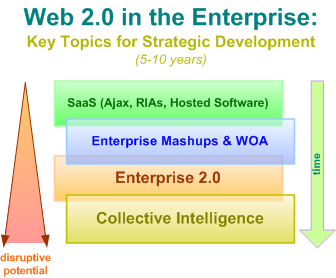Does every organization need a Web 2.0 strategy?

I read with interest this morning Gartner's new 2006 Emerging Technologies Hype Cycle which they released earlier today. Of course, I wasn't too terribly surprised to find that Web 2.0 figured prominently at the top of the list. Released yearly, the list identifies and analyzes the most hyped new technology trends. I find the Hype Cycle to be both good reading as well as a useful reality check. The report does make one thing clear; Web 2.0 will have significant business impact in the next half-decade and companies everywhere are having to consider directly how it affects them and their business strategies.
Of the four aspects of Web 2.0 that Gartner mentions, three of them -- including Social Network Analysis, Ajax, and Collective Intelligence -- are rated as either transformational or having a high potential business impact. In fact, Gartner's analysis of one of the most important elements of Web 2.0 (some would say it's the core), collective intelligence, is identified as probably the most transformational -- if long-term -- trend to watch:
Collective intelligence, rated as transformational (definition: enables new ways of doing business across industries that will result in major shifts in industry dynamics) is expected to reach mainstream adoption in five to ten years. Collective intelligence is an approach to producing intellectual content (such as code, documents, indexing and decisions) that results from individuals working together with no centralized authority. This is seen as a more cost-efficient way of producing content, metadata, software and certain services.
But five to ten years before it becomes mainstream? I'm reminded of my colleague Coach Wei's recent admonition that "every organization should have a Web 2.0 story." To answer the eponymous title of this post: Yes, the clock is ticking folks and long lead times like this, particularly in the IT industry, have been known to induce complacency.

The reality is however, in order to join the mainstream, most organizations will need to start today; reformulating, and even outright reinventing, their ways of doing business. This is not something to be taken lightly, causing many organizations to take their first steps carefully. Making a potentially generational change is not only hard work, but requires tedious trial and error, a significant amount of risk, and often a considerable investment in time and money. Of course, the promise is that the rewards are worth it and your business model will survive whatever dislocation the mass adoption of Web 2.0 business models could potentially cause.
Read a great new piece by Microsoft's Michael Platt on the new opportunities in the enterprise offered by Web 2.0 and the New Internet
There's no doubt that trying to envision how Web 2.0 changes traditional business models a priori is difficult. That might be because Web 2.0 offers a sort of inverted way of looking at the way we do things now. Web 2.0 frequently embodies the emergent and freeform instead of the predefined and structured. It's often bottom-up instead of command-and-control. It's self-service instead of being mediated. The list goes on. And all of them lead into the ways that organizations will likely to have to refocus their business strategies. Based on what we're seeing now, organizations need to make conscious and informed decisions on what aspects of Web 2.0 they believe will affect them in the next few years and then move this thinking into strategic action. But whatever is decided, it's not necessarily about what organizations could do on high, more importantly, it's about what organizations could let emerge if they employ the right Web 2.0 architectures.
What are the aspects of Web 2.0 to worry about and when?
In general, I think Gartner is excellent at taking the current temperature of the industry. But it's very hard for even the best analysts to predict the future. That being said, some parts of Web 2.0 are easier to understand and implement, taking Software as a Service as one good example. Of course, SaaS is fairly well understood today and it's much less transformational than figuring out, say, how to plug your customers and partners into a Web-based social network and then triggering network effects to rapidly build emergent communities and shared knowledge. This wide spectrum of thinking can be daunting but fortunately, there's still time to figure out how the more disruptive aspects of Web 2.0 affect your organization.
The graphic up top presents a very initial but likely credible view of the horizon we're talking about when thinking about an organization's Web 2.0 strategy. The one here differs from Gartner slightly and very much reflects that industry thinking is still rapidly evolving. More importantly, it's just my personal take. Here's a run-down of each of the strategic elements in a possible Web 2.0 strategy:
- Software as a Service: Software (and heck, delivery mechanisms for most any type of service) is moving to the Web. At its most extreme, the Web becomes the platform, and even companies like Microsoft that make their bread and butter from platforms outside of the Web understand this. SaaS has numerous advantages from cost-reduction, to high-levels of convenience, low-levels of maintenance, and now, with RIA technologies like Ajax, browser-based software can be as good or better than PC software. And Ajax encourages developers to head down the path to emergent innovation in online software including things like mashups and situational software. Probable Time to Go Mainstream: 1-3 years.
- Enterprise Mashups and WOA: I've written recently about the woeful lack of good enterprise mashup tools, but that will change soon as I'm continuing to hear about numerous startups tackling this space. While Gartner gives mashups a medium grade as far as their impact, I believe it's possible that considerable pent-up exists demand within most organizations for a large number of small self-service solutions. However, if mashups purely end up as a developer-only phenomenon (though I don't think they will at all if we look at what's happening on the Web) then this might not be the case. Web-Oriented Architectures (WOAs) enter the enterprise picture as the lightweight edge of traditional SOAs that offer both internal and external business partners a Web-compatible way to connect, integrate, and mash-up. Also, WOAs are browser-friendly and if SaaS is the future, then SOAs have non-trivial impedance here. In total, these two will probably take a bit longer than SaaS but has slightly bigger bang for the buck. Probable Time to Go Mainstream: 2-4 years.
- Enterprise 2.0: This is the use of emergent, freeform social software within companies for collaboration and knowledge sharing. Because of its greater impact to the organization, fully mainstream use of Enterprise 2.0 will take time, particularly as it becomes a full-scale collective intelligence play, depending on how it's built and what audience it's aimed at. You can read about Enterprise 2.0 here particularly around the use of enterprise-class blogs and wikis to enable ad hoc teams working on complex, collaborative problem solving (and then make the results available to the rest of the organization.) The proper infrastructure needs to be developed to make EW2.0 happen including enterprise search, recommendation engines, social tagging, and more. As I discussed in the past, there are some hard-headed reasons to believe Enterprise 2.0 can greatly boost productivity and innovation when applied effectively. Note that there are significant obstacles to Enterprise 2.0 in some ways, ranging from the view that blogging is for consumers to changing the daily work habits of an entire entrenched organization. Probable Time to Go Mainstream: 3-6 years.
- Collective Intelligence: This is the most potentially disruptive and powerful aspect of Web 2.0. From contextual data sharing to creating unique and highly valuable community databases of information, harnessing collective intelligence is a fundamentally decentralized activity that aggregates the collective output of a set of connected users on a network. The now-famous examples of YouTube and MySpace are just two instances that show the large-scale creative power of creation on the edge of the network. It's worth keeping in mind that we're at the very beginning of this phenomenon, and while the visible results of these consumer Web 2.0 sites can appear crude, you can bet that as architectures of participation improve, that very finely-tuned results can be elicited. From an enterprise perspective, developing collective intelligence can be done within, outside, or across the firewall and all three audience models will be important to organizations. In this way, strategically applying and tactically executing Web 2.0 techniques will probably be a signficant new discipline in business since it can potentially generate truly vast results to those that do it well. Time to Go Mainstream: 4-7 years?
Large companies of course will often struggle the most with their Web 2.0 strategy due to organizational inertia and the lag that comes from changing any very large system. Interestingly, it's now hard to say whether it'll be the companies with the most organizational discipline, or the least, that will be able to most effectively leverage Web 2.0; lack of excessive central control could potentially be an advantage in this newer way of doing things.
In any case, I think it's going to be one of the more fascinating stories of the decade to track, and I hope you come by to hear about the latest and discuss it.
What do you think is missing from this picture? Remember, these are the big pieces only. How else will Web 2.0 affect our lives and businesses?